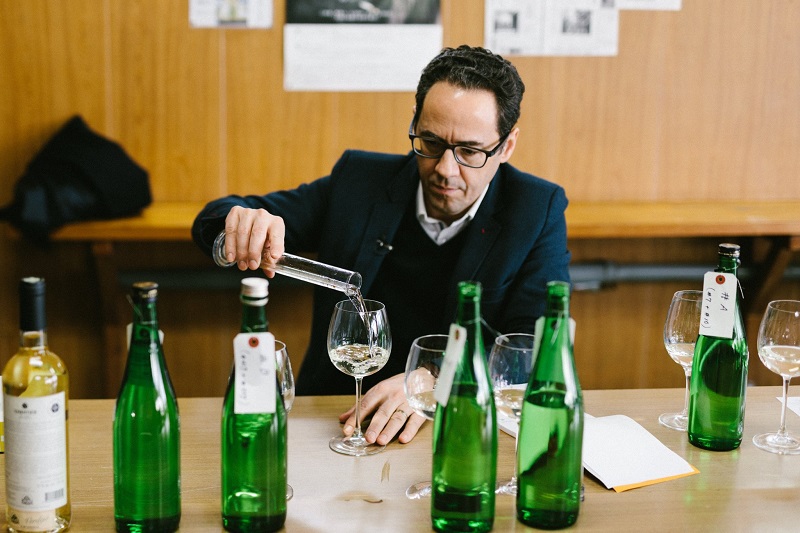
Japanese washu bar RokuNana is the first restaurant of many that will be creating pairing menus highlighting the sakés in the coming months (Photo: Sakekami)
The world of saké is inherently Japanese. Made by its people for its people, saké — or, more accurately, nihonshu, meaning Japanese alcohol (saké covers alcohol in general) — is more than just a national beverage. It is intricately woven into the country’s culture and tradition. It is an art form, a blessing from the land that cements special relationships and is offered to the gods.
Saké is largely an internal industry that targets locals. It is not as approachable as wine, first, because of the language. It is hard to make an informed decision on your own when picking a bottle off the shelf unless you understand Japanese or possess a good amount of saké knowledge. Second, it can be found, most of the time, only in Japanese restaurants. These, in addition to other factors, have made saké somewhat obscure and inaccessible to “outsiders”. Having said that, we are at the cusp of an evolutionary phase, one that goes beyond its usual bubble.
Saké is made by fermenting only one variety of rice — single-origin, if you will. Blending saké is unheard of and the technique is more commonly used in wine and whisky. But, in recent years, blended sakés are slowly assimilating into the market, to the surprise of many. There will always be controversy when there are clashes between the old and the new. After all, if it ain’t broke, don’t fix it. And any sort of disruption to the norm requires some getting used to. But don’t knock it until you’ve tried it.
tanaka_x_chartier.jpg

The forerunners of this change are two foreigners, both of whom have reached the pinnacle of expertise in winemaking and are applying their wealth of knowledge to blend rice instead of grapes. The Tanaka 1789 x Chartier and Iwa 5 Assemblage 2 saké, brought in by wine and spirits importer Sakekami from K2 Marketing, officially launched in Malaysia early November at Japanese washu bar RokuNana in Publika Shopping Gallery, Kuala Lumpur. RokuNana is the first restaurant of many, including Dewakan, Yakiniku Great Kuala Lumpur, Entier French Dining and Rare The Food Company, that will be creating pairing menus highlighting the sakés in the coming months.
An aroma expert and specialist, Francois Chartier is one of the world’s most respected sommeliers. Besides having published 26 cookbooks and working with the biggest names in gastronomy, he is also eminent for his blending skills and research into aromatic science and molecular harmonies.
Chartier was called on by the new leadership team at Tanaka Shuzoten, one of Japan’s oldest saké breweries, which was seeking to chart a new strategy for the global consumer market, targeting especially wine lovers. The collision of worlds resulted in two unique saké blends with a higher acidity and umami structure versatile enough to pair with global cuisines.
“We all know about the pairing of food and saké, food and wine,” says Chartier in a video call. “We think about the texture, acidity, bitterness, sweetness, umami, coldness, freshness and spiciness, but we don’t talk about the aroma. I think the aroma is much more important than everything else.”
francois_chartier.jpg

After years of studying the molecular structure of food, the Canadian developed a one-plus-one-equals-three equation to better describe the potential of understanding the chemical reactions that govern the harmony between wine and food. In other words, matching foods with the same dominant molecules multiplies and magnifies the pleasure of consumption. His research is also making waves in the academic world, with its most recent development being a partnership with the University of Barcelona on establishing a chair to promote the study of aromas in the field of gastronomy.
Science is the basis of Tanaka 1789 x Chartier, and it appears not only in the formulaic guide that leads the blending process, but also its emblem, in the form of a hexagon, which is the structural representation of the common molecule. The symbol is also inspired by the architecture of Tanaka Shuzoten, specifically the tile patterns on its walls from the Edo Period. The bottle shape is unorthodox for saké but it lends to the changing perception of the local market in welcoming a saké with qualities similar to wine.
Right off the bat, the Tanaka 1789 x Chartier is undeniably fragrant, noticeably so even through a face mask. Dominant aromas are aniseed and fresh basil but fruity hints of banana and pineapple can be picked up in addition to fragrant brioche, owed to the three types of yeast used to give richness. The mouthfeel is dense, round and creamy with a vivid final feel. It effortlessly glides down the latitude while leaving a long trail.
Saké also has the superpower to shapeshift according to temperature, providing entirely different experiences, depending on whether it is warm or chilled. When Tanaka 1789 x Chartier is colder, at about 8°C, it resembles Sauvignon Blanc, explains Chartier. It is choppier and the acidity is sharper. When it reaches 12°C to 16°C, it will feel more like a Chardonnay, full-bodied with spices and umami. At 20°C, it completely embodies its junmai (pure rice) identity. It is supple, full and has a long aftertaste.
“I don’t think it’s good to change so much of saké to resemble wine,” Chartier says. “It’s better if we just make wine. This has the soul of saké with the spirit of wine.”
The creation of Iwa 5 is nothing short of extraordinary and the man leading its troop of highly esteemed contributors — saké expert Ryuichiro Masuda of Masuda Shuzo, architect Kengo Kuma and designer Marc Newson — is Richard Geoffroy, who was Dom Pérignon’s chef de cave for 28 years.
“I have been working on the universal principles of harmony and the balance of complexity in different fields,” says Geoffroy, who established Iwa 5 a year after passing the baton to Vincent Chaperon in 2018. “And that quest for harmony has been definitely drawing me to Japan.”
In his pursuit, Geoffroy found that with saké, the focus is more on the nose than palate. “You know, the assessment of saké in Japan is really more about the fragrance, the scent, the perfume and the high note. I felt like reworking the equilibrium.
“I’ve been working on balance all my life because the point of balance makes it weightless. If you can achieve richness, substance, texture, something satisfying enough without the weight, when there’s very little sense of gravity, to me, it’s magic.”
richard_geoffroy_iwa_5.jpg

Five is known to be the universal number of balance and harmony. For Iwa 5, it represents the assemblage of elements — the types of saké rice, origins of the rice, yeast propagation method, types of yeasts used and the maturation processes — that make up its saké. Iwa 5’s Assemblage 1, its first attempt at balancing the scale between the nose and palate, is layered and plays with uncommonly dark aromatics. For our tasting, however, we sampled the Assemblage 2, a saké that emphasises even purer and heightened aromatics with a subtle and vibrant scent.
If champagne is like tasting stars as Dom Pérignon so famously described it, then Assemblage 2 is likened to shooting stars. When extremely cold, it is luminous and crystalline, but becomes more prominent and vibrant as the temperature rises. At 18°C, it is sapid, full-bodied and subtly mellow and earthy. It is a very complex but balanced and elegant saké that revolves around palatability, making it suitable for a variety of dishes. A notable quality of Assemblage 2 is that the tail end is almost ephemeral, it goes down completely the moment your lips leave the glass. But one sip is enough to leave you starstruck.
“I confess Iwa is a bit less expressive on the nose, but way more on the palate,” Geoffroy says. “This saké has to be enjoyed more on the palate than anything.”
Many limit the opportunities of partaking saké within the bounds of washoku (Japanese cuisine) such as sushi or sashimi, but Geoffroy advises branching out. “I’m experimenting in the mixing, taking risks in the making. You should be experimenting and taking risks in the drinking.”
But that is not to say you have to finish the whole bottle immediately. Great sakés are always able to age very well even after opening, says master saké sommelier Danny Leong, who was at the launch. “Make sure you keep a few [bottles] and see the ageing potential of this one. It is one of the more complex junmai daiginjo, especially polished to such a small size of 35%.”
The bottle design alone is enough to secure a spot on any collector’s shelf. Designed by Newson, the vessel has a dark, velvety sheen with the Iwa mark — drawn by calligrapher Mariko Kinoshita in collaboration with designer Hideki Nakajima — fused onto the body as a thin layer of flat white glass. The black varnished cap is made of solid glass, emitting a decidedly satisfying “clink” when opened that drew the attention of fellow diners in the room.
When Geoffroy launched Iwa 5 in Japan last May, he was extremely anxious about the response, especially from the Japanese. “The best compliment I’ve ever had in Japan was that people were experiencing a new sensation. It made me so happy. I didn’t want to be flattered, but when long-time saké drinkers tell you they are experiencing a new sensation … I was having a ball. I was the happiest man on earth.”
Purchase the Tanaka 1789 x Chartier and Iwa 5 Assemblage 2 at Sakekami here.
This article first appeared on Nov 22, 2021 in The Edge Malaysia.


